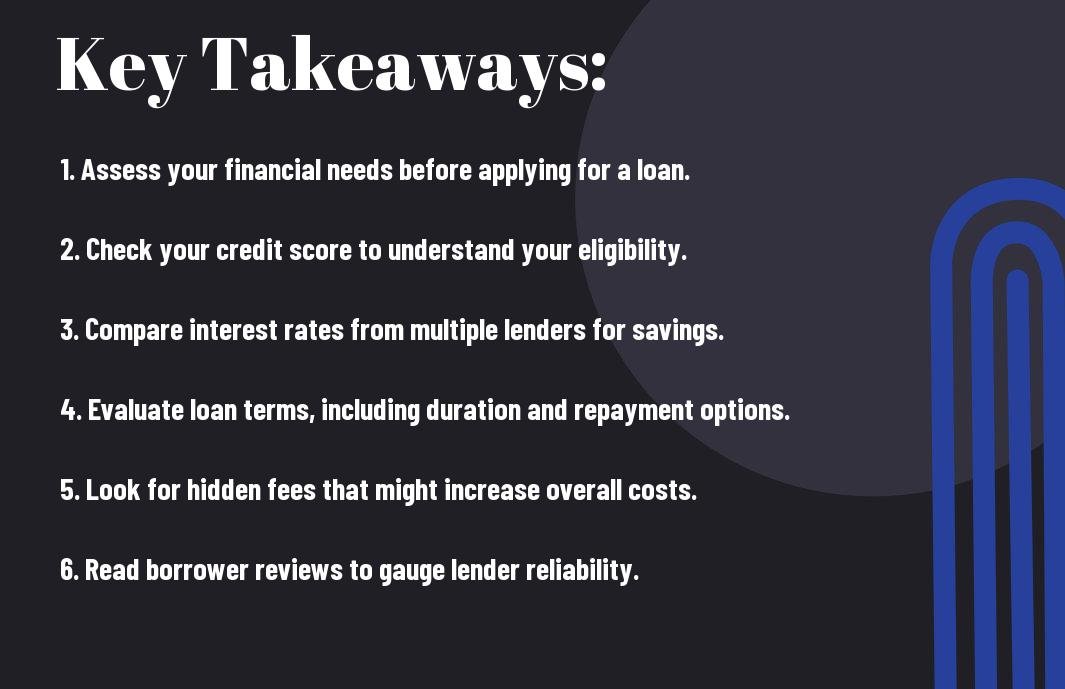Personal finance can feel overwhelming, but it doesn’t have to be. If you’re looking to secure a personal loan, it’s vital to focus on your goals and financial health. In this step-by-step guide, you’ll uncover the ways to evaluate your options and find the perfect loan that aligns with your needs and budget. Don’t miss out on insights in The Ultimate Guide to Personal Loans, and let’s make this journey smoother together!
Key Takeaways:
- Assess Your Financial Needs: Determine the amount you need and the purpose of the loan to find options that align with your objectives.
- Compare Interest Rates: Shop around and analyze interest rates from various lenders to secure the most favorable terms.
- Check Loan Terms: Review repayment terms, fees, and flexibility to ensure they fit within your budget and financial plan.
Understanding Personal Loans
For many people, personal loans provide a flexible financial solution to cover unexpected expenses, consolidate debt, or fund major purchases. These loans allow you to borrow a specific amount of money with a fixed interest rate, which you’ll pay back in installments over a set period. They can be a powerful tool if used wisely, so it’s crucial to understand their basics before committing to one.
Types of Personal Loans
Below is a breakdown of various types of personal loans you can explore:
| Unsecured Loans | No collateral required, higher interest rates. |
| Secured Loans | Collateral is required, usually lower rates. |
| Debt Consolidation Loans | Combines multiple debts into one. |
| Home Improvement Loans | Specifically for home renovations. |
| Payday Loans | Short-term, high-interest loans, often risky. |
Knowing these options helps you to make an informed decision tailored to your financial needs.
Key Terminology Explained
One crucial aspect of navigating personal loans is understanding the terminology that surrounds them. Terms like APR, credit score, and loan term can make or break your borrowing experience.
Explained, the APR (Annual Percentage Rate) represents the total yearly cost of borrowing, which includes interest and fees—this is what you pay to borrow money. Your credit score is a key indicator that lenders use to assess your creditworthiness; a higher score generally means better loan terms. The loan term is the time frame over which you’ll repay the loan. It’s vital to grasp these terms to understand the impact on your financial future, as they play a significant role in shaping the costs and risks associated with your loan options. Get it right, and you can steer your finances in the right direction!

Assessing Your Financial Needs
Some find it challenging to identify the financial needs that can be met with a personal loan. It’s crucial to take stock of your situation to make an informed decision. Check out this Personal loans first-timer’s guide: 7 questions to ask to help clarify your objectives and avoid costly mistakes down the line.
Determining Loan Amount
Before diving in, you’ve got to pinpoint how much you really need. Jot down all your costs and weigh them against your budget to find a sweet spot that covers your needs without pushing you into financial trouble.
Understanding Your Repayment Capacity
Financial responsibility is your best friend when it comes to personal loans. You must evaluate your budget, monthly expenses, and income to understand how much you can commit to repayments without losing sleep. Your ability to repay a loan isn’t just about the monthly payment; it’s also about ensuring you stay in control of your finances. Failing to factor in unexpected costs can lead to overwhelming debt. Acknowledge that protecting your financial health is paramount. Make sure whatever amount you borrow keeps the positive vibes flowing in your financial life!
Researching Lenders
After you’ve outlined your loan needs, it’s time to examine the lender landscape. Look beyond your typical options—explore banks, credit unions, and online lenders. Each will offer unique terms, rates, and flexibility. Don’t just accept the first offer; shop around! Compare rates, fees, and customer service to find the best fit for your personal loan. Your financial health is at stake—so put in the effort to ensure you’re working with the right lender.
Traditional Banks vs. Online Lenders
At this stage, you’ll want to weigh the pros and cons of traditional banks against online lenders. Traditional banks can offer stability and sometimes better rates, but their application process can be lengthy and rigid. Online lenders, on the other hand, usually provide a faster application process with more flexible requirements, but you need to vet them carefully.
Evaluating Lender Credibility
On your quest to find a trustworthy lender, it’s imperative that you evaluate their credibility. Look for customer reviews, ratings on platforms like the Better Business Bureau, and verify their licensing. Reach out to friends or family for recommendations and double-check that the lender is reputable.
To further enhance your evaluation, it’s crucial to dig deep into the lender’s history and customer service. Check if they have any legal issues or complaints, as this can indicate potential red flags. A lender’s responsiveness and willingness to answer your questions is also telling—they should be transparent about their rates and terms. Never underestimate the power of trust; you want a lender who respects you and your needs. Be diligent and choose wisely, as a solid lender will set you up for success!
Comparing Loan Offers
To get the best deal on your personal loan, it’s vital to compare different loan offers. When you do your homework, you can find the option that fits your needs without breaking the bank. Start by breaking down critical details into an easy-to-read format to ensure you’re making a smart choice.
Comparison Table
| Criteria | Details |
|---|---|
| Interest Rates | Varies by lender; affects monthly payments |
| APR | Combines interest and fees; shows true cost |
| Fees | Origination, prepayment, late; can add up |
Interest Rates and APR
Beside the sheer amount you’re borrowing, interest rates and APR are fundamental factors that dictate your monthly payments. A lower rate can mean more money in your pocket, while a higher rate eats into your budget. Always look for the lowest possible rates that suit your credit profile to help you save.
Fees and Other Costs
One significant aspect often overlooked is the fees and other costs associated with personal loans. These can include origination fees, late payment fees, and even prepayment penalties. Be proactive by asking lenders about these costs upfront, because they can affect the overall cost of your loan.
Interest rates just give you the surface view; you need to consider overall fees to dig deeper into the real cost of borrowing. Ensure you fully understand how fees impact your total repayment, as they can dramatically inflate the amount you owe and affect your financial health down the line. Keep your eyes peeled and challenge those fees—every dollar counts.
Application Process Simplified
Despite the overwhelming amount of information out there, the personal loan application process can be pretty straightforward if you break it down. You’re just a few steps away from securing your funds, so let’s make sure you’re ready to take on this journey with confidence and clarity.
Required Documents
Across various lenders, you’ll typically need a few imperative documents to kick off the process. These documents usually include proof of identity, income verification, employment details, and information about your credit history. Gathering these upfront can save you time and keep things *smooth*.
Tips for a Smooth Application
On your path to securing that personal loan, a few tips can make all the difference. Start by being *organized* with your documentation, knowing your credit score, and understanding your financial needs. Here are some solid pointers:
- Check your credit score beforehand.
- Compare interest rates from different lenders.
- Fill out the application accurately.
Any errors can set you back, so being meticulous is key!
A little preparation goes a long way in this process. You want to stand out as a reliable borrower, so keep these strategies in mind:
- Submit all required documentation promptly.
- Maintain open communication with your lender.
- Provide any additional information they might need.
Any effort you put in upfront can lead to a smoother and faster loan approval, giving you the confidence you need to move forward!

Managing Your Loan Effectively
Unlike a credit card, managing your personal loan effectively requires discipline and a proactive approach. You want to keep your payments on track and avoid any pitfalls that could lead to financial strain. Making timely payments not only helps maintain your credit score but also saves you from unnecessary interest charges. The key is to have a solid plan in place—this is about leveraging the loan to enhance your financial future, not letting it weigh you down.
Budgeting for Repayments
Below, you need to create a realistic budget that includes your loan repayments. Start by assessing your income and expenses, focusing on areas where you can cut costs. Allocate a specific amount each month for your loan repayment to ensure you stay on top of it. By treating your loan payment like a vital bill, you can manage your finances more effectively and reduce stress.
Strategies to Pay Off Early
At the same time, you should consider strategies to pay off your loan early. This not only reduces the total interest paid but also frees up your cash flow sooner. Consider making extra payments whenever possible, or even rounding up your monthly payment—every little bit adds up. You could also explore refinancing for a better rate if your financial situation improves.
Another great tactic is to use any windfalls—like tax refunds or bonuses—to make additional payments on your loan. This is a game-changer! You can significantly reduce your principal balance and cut down on interest charges in no time. Just be careful—you don’t want to compromise your emergency fund. By prioritizing these extra payments, you’ll be taking control of your financial destiny and setting yourself up for success.
Final Words
The key to picking the perfect personal loan boils down to knowing your needs, doing your homework, and being real with what’s out there. You’ve got to dig deep into your options, comparing rates and terms like a boss. Don’t rush it—this is your money and your future, so take the time to make an informed choice. When you align the right loan with your financial goals, you’ll feel empowered to tackle whatever comes your way. Now go out there and grab what’s rightfully yours!
FAQ
Q: What factors should I consider when choosing a personal loan?
A: When identifying a personal loan, consider the loan amount you need, the interest rate being offered, the loan term, any origination fees, and your ability to repay. Additionally, evaluate your credit score as it can significantly affect your loan terms. Research different lenders to compare their offers and ensure you’re getting the best deal possible.
Q: How do I determine the amount of money I should borrow?
A: To determine the loan amount you should borrow, start by assessing your financial needs. Create a detailed budget that includes any expenses the loan will cover, such as medical bills, home improvements, or debt consolidation. Ensure that the loan amount aligns with your repayment capabilities to avoid financial strain.
Q: What is the difference between secured and unsecured personal loans?
A: Secured personal loans require collateral, such as a car or savings account, which the lender can claim if you fail to repay. Unsecured personal loans, on the other hand, don’t require collateral but usually come with higher interest rates as they pose more risk to the lender. Weigh the pros and cons of each option based on your financial situation and willingness to pledge assets.
Q: How can I improve my chances of getting approved for a personal loan?
A: To increase your chances of approval, check your credit report for errors and rectify them, reduce existing debt, and ensure you have a stable income. Consider applying for loans with a co-signer if your credit is not strong enough on its own. Additionally, borrowing within your means can make lenders more likely to approve your application.
Q: What hidden fees should I look out for in personal loans?
A: Hidden fees often include origination fees, late payment fees, prepayment penalties, and insufficient funds fees. Read the loan terms carefully and ask lenders about any charges that may arise during the life of the loan. This will help you gain a comprehensive understanding of the total cost of borrowing and aid your decision-making.
